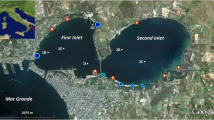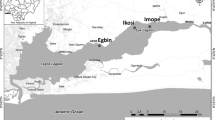Abstract
The Curonian Lagoon (a lagoonal ecosystem with predominantly freshwater conditions) is a hypertrophic reservoir. Throughout the entire water area, including the coastal zone, which is of important fishery and recreational importance, phytoplankton blooms are observed annually. Monthly data obtained in 2014–2015 on chlorophyll a and hydrochemical parameters have been analyzed. The seasonal dynamics of chlorophyll a (phytoplankton abundance) throughout the Russian waters of the Curonian Lagoon and the influence of phytoplankton blooms on hydrochemical and microbiological indicators in the coastal zone near the Curonian Spit National Park (UNESCO World Heritage List) are analyzed. During the period of intensive development of cyanobacteria (“hyperbloom”), it’s spatial distribution in Russian waters, assessed by chlorophyll, is preconditioned by the wind regime, which causes local accumulation in certain areas. The accumulation of phytoplankton in the coastal zone (including the area along the Curonian Spit National Park) in summer and autumn may form harmful hydrochemical and microbiological conditions, corresponding to hypertrophic and hypersaprobic levels and multiple excesses of the maximum permissible concentration (BOD5 and ammonia nitrogen; anaerobic conditions).




Similar content being viewed by others
Notes
UNESCO World Heritage List. http://unesco.ru/unescorussia/sites/.
GOST 17.1.04.02–90: Water. Method for Spectrophotometric Determination of Chlorophyll a.
Guidelines 4.2.1884–04: Sanitary–Microbiological and Sanitary–Parasitological Analysis of Water from Surface Water Bodies. Approval date March 3, 2004.
Order of the Ministry of Agriculture no. 552 of December 13, 2016, On Approval of Water Quality Standards for Water Bodies of Fishery Importance, Including Standards for Maximum Permissible Concentrations of Harmful Substances in the Waters of Water Bodies of Fishery Importance. Registered with the Ministry of Justice of Russia on January 13, 2017, no. 45203.
Resolution of January 28, 2021, no. 2. On the Approval of Sanitary Rules and Morms SanPiN 1.2.3685-21 Hygienic Standards and Requirements for Ensuring the Safety and/or Harmlessness of Environmental Factors to Humans. Registered with the Russian Ministry of Justice on January 29, 2021, no. 62296.
Cyanobacterial toxins: microcystins. Background document for development of WHO Guidelines for Drinking-Water Quality and Guidelines for Safe Recreational Water Environments. 2020. Geneva: World Health Organization (WHO/HEP/ECH/WSH/2020.6).
GOST 17.1.04–77: Nature Protection. Hydrosphere. Indices of State and Regulation for Valuation Survey of Fishery Waters.
REFERENCES
Aleksandrov, S.V., Impact of blue-green algae “nuisance” on ecological status of the Couronian lagoon, Voda: Khim. Ekol., 2009, no. 4, p. 2.
Aleksandrov, S.V. and Gorbunova, Yu.A., Phytoplankton production and chlorophyll content in different types of estuaries, Vestn. Balt. Fed. Univ. im. I. Kanta, 2012, no. 1, pp. 90–98.
Aleksandrov, S.V., Senin, Yu.M., and Smyslov, V.A., Primary production, chlorophyll content and nutrients as indicators of the ecological state of the Curonian and Vistula Lagoons of the Baltic Sea, Biol. Vnutr. Vod, 2006, no. 1, p. 41.
Aleksandrov, S., Krek, A., Bubnova, E., et al., Eutrophication and effects of algal bloom in the south-western part of the Curonian Lagoon alongside the Curonian spit, Baltica, 2018, vol. 31, no. 1, p. 1. https://doi.org/10.5200/baltica.2018.31.01
Barinova, G.M., Climate, in Kaliningradskaya oblast’: ocherki prirody (Kaliningrad Oblast: Essay about Nature), Kaliningrad: Yantarnaya Skazka, 1999.
Bartoli, M., Zilius, M., Bresciani, M., et al., Drivers of cyanobacterial blooms in a hypertrophic lagoon, Front. Mar. Sci., 2018, vol. 5, p. 434. https://doi.org/10.3389/fmars.2018.00434
Bresciani, M., Adamo, M., De Carolis, G., et al., Monitoring blooms and surface accumulation of cyanobacteria in the Curonian Lagoon by combining MERIS and ASAR data, Remote Sens. Environ., 2014, vol. 146, p. 124. https://doi.org/10.1016/j.rse.2013.07.040
Bukaveckas, P., Lesutiene, J., Gasiunaite, Z., et al., Microcystin in aquatic food webs of the Baltic and Chesapeake Bay regions, Estuarine, Coastal Shelf Sci., 2017, vol. 191, p. 50. https://doi.org/10.1016/j.ecss.2017.04.016
Boulion, V.V., Zakonomernosti pervichnoi produktsii v limnicheskikh ekosistemakh (Regularities of Primary Production in Lacustrine Ecosystems), St. Petersburg: Nauka, 1994.
Cetkauskaite, A., Zarkov, D., and Stoskus, L., Water–quality control, monitoring and wastewater treatment in Lithuania 1950 to 1999, Ambio, 2001, vol. 30, no. 4, p. 297. https://doi.org/10.1579/0044-7447-30.4.297
Chervinskas, E., Main features of the hydrological regime, in Kurshyu Mares (Curs-Mares Bay), Vil’nyus: Akad. Nauk Lit. SSR, 1959.
Dmitrieva, O.A. and Semenova, A.S., Seasonal dynamics of phyto- and zooplankton and their interactions in the hypereutrophic reservoir, Inland Water Biol., 2011, vol. 4, no. 3, p. 308. https://doi.org/10.1134/S1995082911030059
Ferrarin, C., Razinkovas, A., Gulbinskas, S., et al., Hydraulic regime-based zonation scheme of the Curonian Lagoon, Hydrobiologia, 2008, vol. 611, no. 1, p. 133. https://doi.org/10.1007/s10750-008-9454-5
Gerb, M.A. and Sokolov, A.A., Coastal-water and coastal vegetation of the Curonian Lagoon within the Curonian Spit National Park, in Problemy izucheniya i okhrany prirodnogo i kul’turnogo naslediya natsional’nogo parka “Kurshskaya kosa” (Problems of Study and Preservation of the Natural and Cultural Heritage in the Kurshskaya Kosa National Park), Kaliningrad: Balt. Fed. Univ. im. I. Kanta, 2011, p. 5.
Gerb, M.A., Polunina, Yu.Yu., Lange, E.K., et al., Characteristics of biological communities of the littoral zone of the western coast of the Curonian Lagoon according to hydrobiological monitoring data in 2015, in Problemy izucheniya i okhrany prirodnogo i kul’turnogo naslediya natsional’nogo parka “Kurshskaya kosa” (Problems of Study and Preservation of the Natural and Cultural Heritage in the Kurshskaya Kosa National Park), Kaliningrad: Balt. Fed. Univ. im. I. Kanta, 2016, vol. 12.
Hakanson, L. and Boulion, V.V., The Like Foodweb–Modeling Predation and Abiotic/Biotic Interactions, Leiden: Backhuys, 2002.
Jeffrey, S.W. and Humphrey, G.F., New spectrophotometric equations for determining chlorophylls a, b, c 1 and c 2 in higher plants, algae and natural phytoplankton, Biochem. Physiol. Pflanz., 1975, vol. 167, no. 2, p. 191. https://doi.org/10.1016/S0015-3796(17)30778-3
Kaziukonyte, K., Lesutiene, J., Gasiunaite, Z., et al., Expert-based assessment and map** of ecosystem services potential in the Nemunas Delta and Curonian Lagoon region, Lithuania, Water, 2021, vol. 13, p. 2728. https://doi.org/10.3390/w13192728
Kudryavtseva, E.A., Aleksandrov, S.V., and Dmitrieva, O.A., Seasonal dynamic of primary production in the coastal zone of the south-eastern Baltic sea, Okeanol. Issled., 2018, vol. 46, no. 3, p. 99. https://doi.org/10.29006/1564-2291.JOR-2018.46(3).7
Minkyavichus, A. and Pipinis, I., Overview of the flora and vegetation of the Curs-Mares Bay, Kurshyu Mares (Curs-Mares Bay), Vil’nyus: Akad. Nauk Lit. SSR, 1959.
Olenina, I., Long-term changes in the Kursiu Marios lagoon: Eutrophication and phytoplankton response, Ecologija, 1998, vol. 1, no. 1, p. 56.
Overlingė, D., Toruńska-Sitarz, A., Kataržytė, M., et al., Characterization and diversity of microcystins produced by Cyanobacteria from the Curonian Lagoon (SE Baltic Sea), Toxins, 2021, vol. 13, p. 838. https://doi.org/10.3390/toxins13120838
Paldaviciene, A., Mazur–Marzec, H., and Razinkovas, A., Toxic cyanobacteria blooms in the Lithuanian part of the Curonian Lagoon, Oceanologia, 2009, vol. 51, no. 2, p. 203. https://doi.org/10.5697/oc.51-2.203
Pilkaitytė, R. and Razinkovas, A., Factors controlling phytoplankton blooms in a temperate estuary: Тutrient limitation and physical forcing, Hydrobiologia, 2006, vol. 555, p. 41. https://doi.org/10.1007/s10750-005-1104-6
Pilkaitytė, R. and Razinkovas, A., Seasonal changes in phytoplankton composition and nutrient limitation in a shallow Baltic lagoon, Boreal Environ. Res., 2007, vol. 12, no. 5, p. 551.
Rukovodstvo po khimicheskomu analizu morskikh i presnykh vod pri ekologicheskom monitoringe rybokhozyaistvennykh vodoemov i perspektivnykh dlya promysla raionov Mirovogo okeana (Manual on Chemical Analysis of Marine and Fresh Waters in Environmental Monitoring of Fisheries Water Reservoirs and World Ocean Areas Promising for Fisheries), Moscow: Vseross. Nauchno-Issled. Inst. Rybn. Khoz. Okeanogr., 2003.
Rybnye resursy Kurshskogo zaliva: kharakteristika, ratsional’noe ispol’zovanie, puti povysheniya produktivnosti (Fish Resources of Kursiu Marios Lagoon: Characteristics, Rational Use, Methods for Increasing the Productivity), Kalinigrad: Kn. Izd., 1985.
Semenova, A.S. and Aleksandrov, S.V., The zooplankton consumption of primary production and an assessment of the waterbody trophic state on the basis of its structural and functional characteristics, Inland Water Biol., 2009, vol. 2, no. 4, p. 348. https://doi.org/10.1134/S1995082909040099
Stashko, A.V. and Aleksandrov, S.V., Specific features of spatial distribution of hydrochemical parameters in the Curonian Lagoon of the Baltic Sea in 2018–2022, Vodn. Bioresur. Sreda Obitaniya, 2023, vol. 6, no. 1, p. 104. https://doi.org/10.47921/2619-1024-2023
Sulcius, S., Pilkaitytė, R., and Mazur-Marzec, H., Increased risk of exposure to microcystins in the scum of the filamentous cyanobacterium Aphanizomenon flos-aquae accumulated on the western shoreline of the Curonian Lagoon, Mar. Pollut. Bull., 2015, vol. 99, nos. 1–2, p. 264. https://doi.org//10.1016/j.marpolbul.2015.07.057
Trifonova, I.S., Ekologiya i suktsessiya ozernogo fitoplanktona (Ecology and Succession of Lake Phytoplankton), Leningrad: Nauka, 1990.
Tsybaleva, G.A., Kuz’min, S.Yu., and Kazimirchenko, O.V., Hydrobiological and microbiological characteristics of the western coastal zone of the Curonian Lagoon in 2014, in Problemy izucheniya i okhrany prirodnogo i kul’turnogo naslediya natsional’nogo parka “Kurshskaya kosa” (Problems of Study and Preservation of the Natural and Cultural Heritage in the Kurshskaya Kosa National Park), Kaliningrad: Balt. Fed. Univ. im. I. Kanta, 2016, p. 138, vol. 12.
Vybernaite-Lubiene, I., Zilius, M., Saltyte-Vaisiauske, L., et al., Recent trends (2012–2016) of N, Si, and P export from the Nemunas River Watershed: Loads, unbalanced stoichiometry, and threats for downstream aquatic ecosystems, Water, 2018, vol. 10, p. 1178. https://doi.org//10.3390/w10091178
Funding
The analysis of spatial distribution was carried out within the framework of the state assignment of the Shirshov Institute of Oceanology (no. FMWE-2021-0012); analysis of seasonal dynamics was supported within the state assignment of the Immanuel Kant Baltic Federal University (no. FZWM-2023-0004).
Author information
Authors and Affiliations
Corresponding author
Ethics declarations
Conflict of interest. The authors declare that they have no conflicts of interest.
Statement of the welfare of animals. The article does not contain any studies involving animals in experiments performed by any of the authors.
Additional information
Translated by D. Martynova
Publisher’s Note.
Pleiades Publishing remains neutral with regard to jurisdictional claims in published maps and institutional affiliations.
Abbreviations: CFU, colony-forming units; SEB, scientific experimental base; MPC, maximum permissible concentration; O2, oxygen concentration; Chl, chlorophyll; CHEM, Center for Hydrometeorology and Environmental Monitoring; N-N\({\text{H}}_{4}^{ + }\) and Ntotal, ammonium and total nitrogen concentrations.
Rights and permissions
About this article
Cite this article
Aleksandrov, S.V., Smirnova, M.M. Impact of Algae Blooms on the Coastal Zone of the Curonian Lagoon of the Baltic Sea. Inland Water Biol 16, 1043–1051 (2023). https://doi.org/10.1134/S1995082923060032
Received:
Revised:
Accepted:
Published:
Issue Date:
DOI: https://doi.org/10.1134/S1995082923060032




